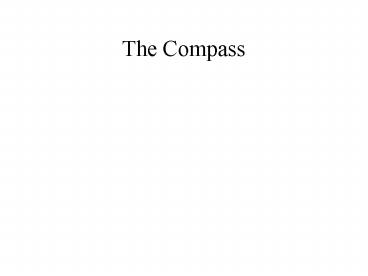The Compass - PowerPoint PPT Presentation
Title:
The Compass
Description:
The Compass Some History As far back as 2500 BCE the Chinese knew that a loadstone on a piece of floating wood, would always point itself in the same direction. – PowerPoint PPT presentation
Number of Views:131
Avg rating:3.0/5.0
Title: The Compass
1
The Compass
2
Some History
- As far back as 2500 BCE the Chinese knew that a
loadstone on a piece of floating wood, would
always point itself in the same direction. - Later with the move from bone to iron needles, it
was noticed that an iron needle placed near a
loadstone would also take on these directional
properties.
3
The Modern Compass
- Modern compasses typically have a magnetic needle
or capsule that floats freely on a central pivot,
so that it can align itself with the earths
magnetic field. - Electronic compasses, with no moving parts, are
made by measuring small currents in coils of
wire, induced by the earths magnetic field.
4
Angular Measurement
- A compass will have a angular measurement ring to
observe the angle between the compass needle and
the compass body. - The most common angular measurement system is a
360 circle. - Other systems include
- Four 90 quadrants
- Mills, a system that divides a circle into 6400
parts - Avoid these for wilderness navigation purposes
5
Sighting Mechanism
- Many compasses include some mechanism for
sighting to a distant point to measure the angle
of the line to that object relative to the
compass needle.
6
Other Features Abound
- Distance Scales
- Magnifying Lens
- Slope Measurement
- etc
7
Compass Uses
- In wilderness navigation a compass is used to do
the following. - General orientation to the 4 cardinal directions
- Taking a bearing to a distant object
- Traveling along a heading
- Plotting or measuring a bearing on a map
- This is using the compass as an expensive
protractor, and does not use its magnetic
direction capabilities.
8
A Look at Some Common Compass Types
9
Zipper Pull Compass
- Good for generaldirection
10
Lensatic
- 5 markings
- So-so for sighting
- Useless for plotting
11
Baseplate
- 2 markings
- Good for map plotting
- Hard to sight ona distant object
12
Mirrored
- 2 markings
- Good for sighting
- Good for plotting
- May have adjustable declination
13
Sighting Baseplate
- 1 markings
- Best for sighting
- Good for plotting
- No declinationadjustment
- My personal favorite!
14
(No Transcript)
15
Parts of a compass
16
Taking a bearing to an object
- Sight to the object with the compass.
- Turn the ring to align the orienting arrow with
the red end of the magnetic needle. - Read the bearing from the ring at the index line.
17
Needle Parallax
View from Above
View from Behind
18
Parallax Side View
19
Needle Parallax
Good
Bad
Keep the needle parallel to the meridian lines.
20
Taking a back bearing
- A back bearing is taken looking back to where you
took the original bearing. - A back bearing is 180 different from a forward
bearing. - An easy technique is to align the south end of
the needle rather than the north end.
21
Classroom compass exercise
- Pair up with another student
- Take a bearing and a back bearing on each other.
- Bearings should agree within /- 2
- Try other positions in the classroom
- Try using other types of compasses































